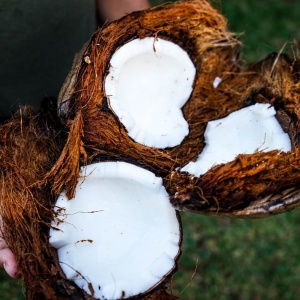
According to this paper, coconut oil cultivation puts a much greater number of species at risk per million tonnes of oil than other oils, including palm oil, despite narratives about the environmental impacts of oils usually focusing on deforestation caused by palm oil cultivation.
The figure below shows the number of species estimated to be threatened by oil cultivation per million tonnes of oil produced. Coconut oil threatens a relatively high number of species because it is often grown on tropical island nations which typically have high levels of species richness compared to mainland areas, as well as hosting many species not found elsewhere.

 Image: Figure 1, Meijaard et al. Global map showing the dominant oil crops per grid cell.
Image: Figure 1, Meijaard et al. Global map showing the dominant oil crops per grid cell.
If the numbers of threatened species were measured per million hectares of cultivated land, the paper notes that oil palm impacts more species (17 species/mha) than coconut (5.3 species/mha). We note that this difference is likely to be partially due to the relatively high yield of palm oil per hectare compared to other oils - see Study on the environmental impact of palm oil consumption and on existing sustainability standards.
Reference
Meijaard, E., Abrams, J., Juffe-Bignoli, D., Voigt, M. and Sheil, D., 2020. Coconut oil, conservation and the conscientious consumer. Current Biology 30, R737–R758.
Read the full paper here. See also the Foodsource building block What is land use and land use change?







Post a new comment »